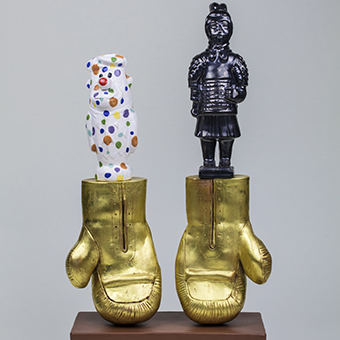
A new exhibition opening at the Hope College Kruizenga Art Museum on Tuesday, May 29, provides a retrospective look at the artistic career of Hope College art professor Billy Mayer, who passed away unexpectedly at age 64 in November 2017. “In Memory: The Art of Billy Mayer” includes examples of Mayer’s work in a broad range of artistic genres, from ceramics and metal sculpture to collages, photographs and mixed-media installation pieces.
 The public is invited. Admission is free.
The public is invited. Admission is free.
The exhibition will conclude with a public reception on Saturday, Sept. 8, from 4 p.m. to 7 p.m. to honor the memory of Billy Mayer. Guided tours of the exhibit will be available every half hour from 10:30 a.m. to 2:30 p.m. A reception will follow the closing of the exhibition at 7 p.m. at the Maas Center auditorium.
In addition, a silent auction for many of the artworks featured in the exhibition will run during the course of the exhibition. All proceeds from the auction will help fund an endowed scholarship in Mayer’s name that will benefit future generations of Hope College art students.
Born and raised in Minnesota, Billy Mayer showed an interest in making art from a young age. According to Charles Mason, who is the director of the Kruizenga Art Museum as well as the Margaret Feldmann Kruizenga Curator of the museum, Mayer’s particular interest in making sculpture and other three-dimensional art forms began in the eighth grade when he visited a museum in Minneapolis and saw works by Chuck Hunington and Henry Moore. That experience inspired him to begin creating his own sculptures at his father’s workbench in the basement of their family home. Mayer later recalled that the drive to make art “started keeping me up at night” as he continued his interest in art through high school and college.
Mayer received a Bachelor of Fine Arts degree from the University of Minnesota in 1976 and a Master of Fine Arts degree from Pennsylvania State University in 1978. He joined the Hope faculty in 1978 and taught at the college for 39 years, chairing the Department of Art and Art History from 1987 to 2004.
Mason noted that shortly after coming to Hope, Mayer achieved notoriety on campus and in the broader Holland community for several large-scale sculpture commissions that generated considerable conversation and some controversy, much to his delight. Throughout his career, Mayer continued to show his artwork in both solo and group exhibitions at museums and galleries throughout the Midwest and across the nation.
Mayer also demonstrated his passion for art through his distinguished teaching career. He was known as an inspiring instructor and generous mentor who challenged his students to combine craft and content at a high level, just as he did in his own work. His enduring legacy as a teacher is evident in the numerous former pupils who have gone on to successful careers as practicing artists and educators.
The title of the exhibition refers not only to the fact that it is a commemorative retrospective on Mayer’s artistic career, but also to the importance of memory in his work. “As is evidenced by many of the pieces featured in the exhibition, his art was often inspired by memories of his childhood and other experiences throughout his life,” Mason said. “Yet while the genesis of the artworks may lie in events from his past, he also meant for the works to evoke memories and feelings in his viewers and wanted everyone to find their own meanings in his art.”
Mason observed that Mayer’s art generously repays close attention and contemplation. “Much of Billy’s work appears humorous or even whimsical at first glance,” Mason said, “but at a deeper level it engages much more serious issues of social identity, cultural values and the impact of technological, environmental and economic change in our daily lives.”
Sealed bids for the silent auction will be taken at the museum, and winners will be notified after the exhibition closes. Anyone wishing to donate to the Billy Mayer scholarship fund apart from the silent auction should contact the college’s development office at 616-395-7775 or development@hope.edu.
Give online to support the Billy Mayer Memorial Scholarship
The Kruizenga Art Museum functions as an educational resource for Hope College and the greater West Michigan community. The museum features two public galleries as well as a classroom and climate-controlled storage space for its 4,500-object permanent collection. It is named in honor of a leadership gift from Dr. Richard and the late Margaret Kruizenga of Holland, both of whom graduated from Hope in 1952. Additional information is available at hope.edu/kam.
The Kruizenga Art Museum is open Tuesdays through Saturdays from 10 a.m. to 4 p.m and is located at 271 Columbia Ave., between 10th and 13th streets. The Maas Center is located at 264 Columbia Ave., between 10th and 13th streets.